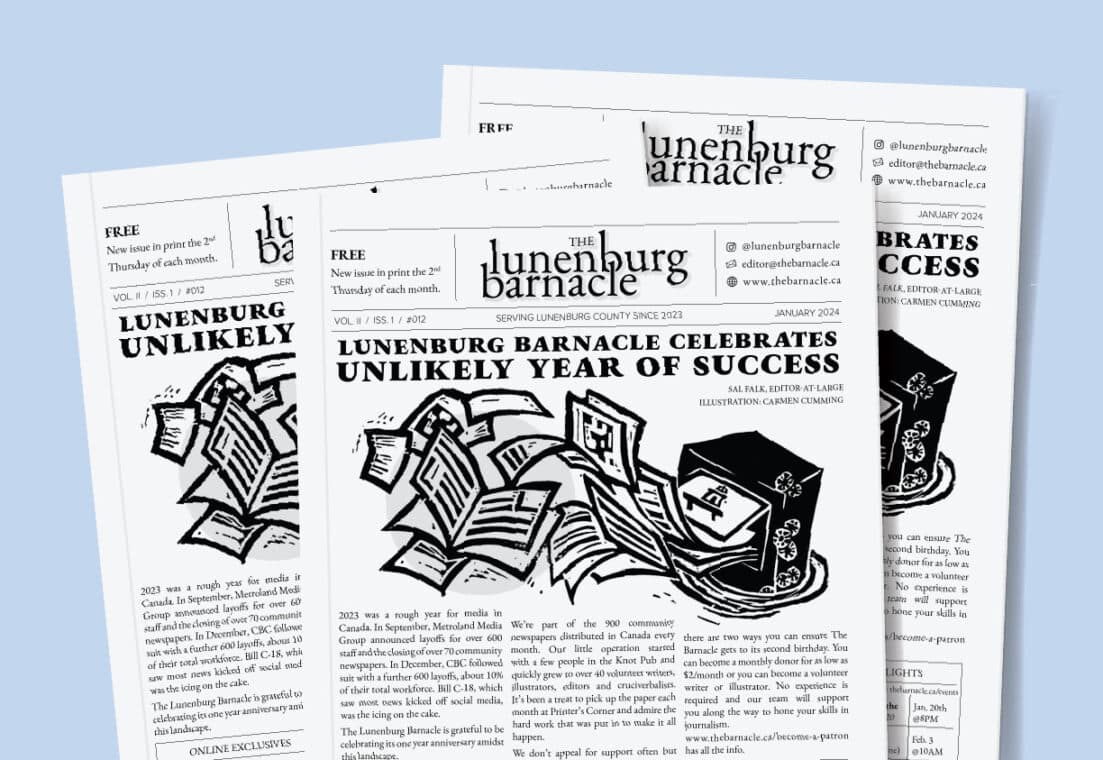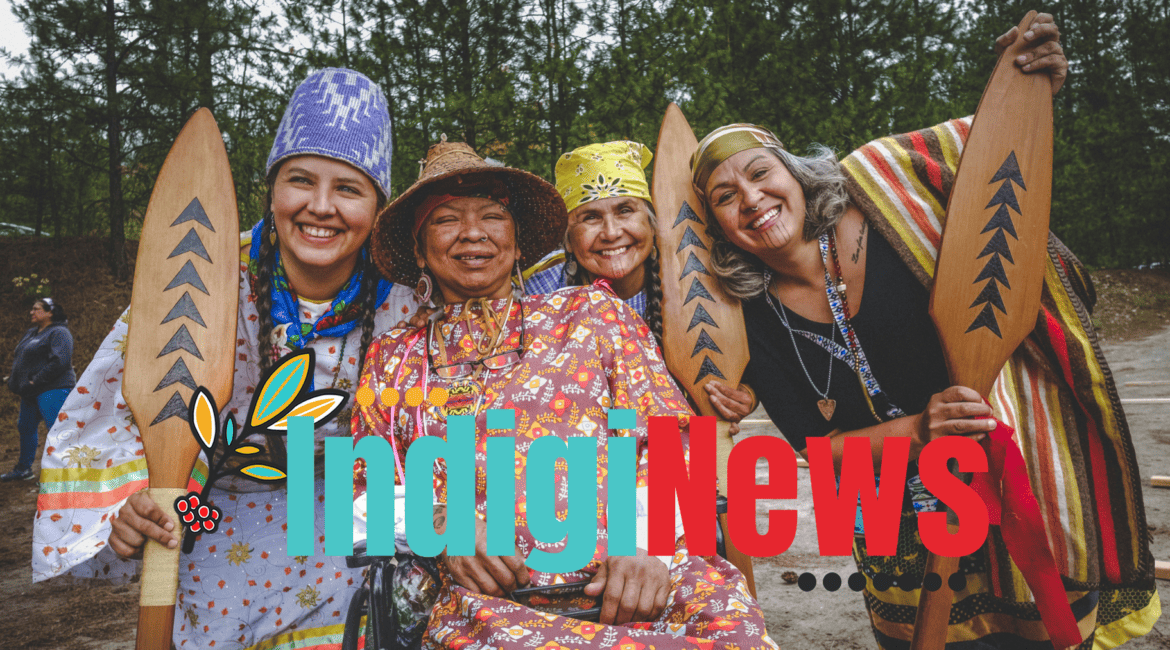The revival of Canada’s local news and information landscape requires an ecosystem approach, and philanthropy can play a critical role through strategic funding.
The first article in this series, “Funding Journalism – For the Sake of Philanthropy and Democracy,” explores issues surrounding the current crisis in journalism, why it’s an essential service, and why it’s time for philanthropy to step into the ring.
Delivery day begins on foot. Just before 8 a.m. on Nova Scotia’s South Shore, Sal Falk, editor-at-large of The Lunenburg Barnacle, readies her stack of newspapers. “We like to say we deliver by bike, by foot, by car, and by boat,” she says. She describes the view of the tall ships in the harbour, the narrow steps of the 169-year-old Victorian house of her first stop: No. 9 Coffee Bar. “You never enter the café on a distribution day without hearing someone say, ‘Oh, there’s the Barnacle.’” Wooden chairs scrape against the floor as people rise to get their copies. Some can’t wait to do the crossword; others pull Falk aside to share story tips.
As the crisis in journalism deepens across Canada, hope springs from scenes like these. For every closure or layoff, there is a journalist or concerned citizen who refuses to throw in the towel. They form part of a small but growing movement to revive our local news and information systems, and they need your help.
Launched a year ago by a young volunteer team dismayed by a lack of local news in their community, the Barnacle serves the roughly 50,000 residents of Lunenburg County (which includes the towns of Lunenburg, Bridgewater, and Mahone Bay). While the team maintains a website with regular updates, the star attraction is their free, once-a-month newspaper, because, says editor-in-chief Jesse Ward, it’s “anachronistic in a really charming way,” and “it makes people smile in a way the internet never would.”

The Barnacle’s popularity is enhanced by its role of filling a gap in the town’s civic discourse. When Ward, a former journalist with CBC and Global News, went to his first town council meeting, counsellors told him no one from the media had been there in four years. Ward’s “old-fashioned town council reporting” has since led to stories being picked up by the national press. A mayoral debate hosted by the Barnacle attracted more than 150 people and was live-streamed to nearly 1,000 viewers.
Ward is realistic, however, about the sustainability of an outlet run by volunteers who all have day jobs. Nevertheless, he sees their $500-a-month operation, which relies on crowdfunding, as “first steps towards what a possible model could be for low- to no-budget community journalism.” Next steps, such as becoming a “qualified Canadian journalism organization” (QCJO) – “gateway” to three income tax measures meant to provide support to journalism organizations – aren’t possible. Small communities face different challenges, Ward notes. For example, QCJO criteria require employing at least two full-time journalists. Requirements of the next tier (becoming a qualified donee as a “registered journalism organization”), such as a complete separation between board members and editorial, won’t work, he says. “Our board members are also our writers and our photographers, and people doing illustration and layout.”
Funders should take it as a given that local news and information systems are essential services in need of investment.
Recently, several foundation leaders have been making the case for why philanthropy should support outlets like the Barnacle. To this end, Inspirit Foundation, the Local News Research Project at Toronto Metropolitan University, and Philanthropic Foundations Canada published Funding Journalism: A Guide for Canadian Philanthropy last November. But a definitive body of research from all over the world makes it clear we have moved beyond the why. Focusing on why is “a waste of time,” notes Molly de Aguiar of the US-based Independence Public Media Foundation. At this stage, funders should take it as a given that local news and information systems are essential services in need of investment, that the public (particularly those who are low income, racialized, or live in rural communities) is not getting the information it needs, she writes. It’s time to focus on the how. How to fund strategically to create a healthy news and information ecosystem. How to fund effectively to allow media outlets to focus energy on performing their essential roles.
How to begin might start with the way we view the news. To see an ecosystem rather than individual outlets. “The dramatic remaking of media demands that we develop new tools and processes for understanding and funding the local news landscape,” notes A Guide to Assessing Your Local News Ecosystem: A Toolkit to Inform Grantmaking and Collaboration. An ecosystem approach acknowledges that news is not just a collection of parts but also the connections and relationships between them – from anchor institutions (newsrooms, libraries, universities) to infrastructure (ownership, access to broadband) to networks (social media platforms, people). Michelle Ferrier, principal investigator for the Media Deserts Project and the Media Seeds Project, who’s been described as a trailblazer in this field, likes the ecosystem model “because I think people understand it in a nature sense – that, you know, we are looking at our keystone species, our newspapers and other legacy papers, as an extinction event,” she says. “We’ve been watching as the new species of news and information becomes hyperlocal,” filling in that gap in the ecosystem, she says.
Philanthropy has a role to play in helping fertilize the soil [to] rebuild the ecosystem so that more players of different types on different platforms can . . . create news and information in these communities.
Michelle Ferrier, Media Deserts Project
By assessing communities’ news and information ecosystems in a multi-layered approach, philanthropy can better understand how and in what ways those ecosystems are broken, Ferrier says. Philanthropy has a role to play, particularly community foundations, “in helping to amend the soil, so to speak, and helping fertilize the soil with funding networks, with partnerships and collaborations that can help rebuild and re-energize the ecosystem so that more players of different types on different platforms can come and build and create news and information in these communities.”
Media experts such as Damian Radcliffe, the Carolyn S. Chambers Professor in Journalism at the University of Oregon, have also shifted focus to how to build a stronger local media ecosystem. But as we shift to a more community-centred, ecosystem perspective, “we need to kind of raise the bar for everybody by having some very honest conversations,” Radcliffe says, so we don’t “just reinvent the wheel.” One conversation that needs to happen is with grantees. “Historically, we’ve overlooked their experience,” he says. “What can we learn from them?” Are calls for funding reaching places potential grantees know about and can access? Do they have the capacity, especially if they’re a smaller newsroom, to write an application in the language a funder wants? What needs to be funded – digital transition, keeping the lights on, a specific beat?
Jeanette Ageson, publisher of The Tyee – a Vancouver-based non-profit publication with a two-decade history of working with both foundations and individual donors – says, “It’s really crucial, right from the outset, to have a pretty frank conversation about what funding journalism is or isn’t.” Editorial independence – a must – should be written into a contract or grant agreement. “You can’t have an end point in mind,” she says. You can’t have an idea of where you’d like the journalist to end up or give them a list of people they need to talk to. “That’s not journalism,” she says, “that’s content creation.” When conversations arise with organizations that aren’t “a good fit,” Ageson sees this as “a misalignment,” an unfamiliarity with the process and the values of journalism. “I don’t assume any ill intent or any kind of manipulation,” she says. “It’s simply an education moment.” (Ageson suggests looking to the Institute for Nonprofit News for best practices.)
There isn’t as much of a tradition in Canada of funding journalism for journalism’s sake, as its own worthy area of funding versus a topic area.
Jeanette Ageson, The Tyee
Similarly, journalism outlets need to educate themselves about how philanthropy works. Fundraising and donor relations are “a field of practice,” Ageson says, “that shouldn’t be underestimated.” If there is no one available in-house to focus their energies on this, beware – “it’s much more work than you think.” The tendency for Canadian funders to want to fund projects or topics doesn’t help matters. Beyond creating more work in terms of application forms and reports, “I think it’s a bit incompatible with what we need in order to fund this infrastructure,” Ageson says. “There isn’t as much of a tradition in Canada of funding journalism for journalism’s sake,” she says, meaning considering journalism “its own worthy area of funding versus a topic area.” While all funding is welcome, “it’s a bit of a subtle shift,” she says, “but an important one.”
This shift applies a more systemic, theory-of-change lens to funding the news ecosystem, she says. What you’re funding is the person, the role. You’re trusting the reporter and the editor “to use their specific professional abilities to do the best job they can do.” Journalism isn’t a project, she says. “It’s a role, right? And it’s a continuous role.” Other essential roles in society, such as nurses or firefighters – “you don’t necessarily expect those people to be putting together new projects every six months,” she says.
I feel like we’re constantly in crisis. And there’s nowhere to really talk about that. Like we’re all just silently thinking, ‘I have no idea if I’ll be around next year.’
Eden Fineday, IndigiNews
Funding for systemic change can also help ensure that news organizations serving historically misrepresented and overlooked communities thrive in this ecosystem. IndigiNews, a free, digital Indigenous-led news platform launched in 2020, has won numerous awards for its impactful storytelling – “from calls for justice and accountability, to powerful moments of change.” But publisher Eden Fineday spends a lot of time worrying. “I feel like we’re constantly in crisis. And there’s nowhere to really talk about that. Like we’re all just silently thinking, ‘I have no idea if I’ll be around next year.’”
Forty percent of Fineday’s funding comes from two main funders supporting IndigiNews until 2025. She’d hoped to triple reader revenue by then (which now stands at 20%). At the halfway mark of her funding period, “I now believe that’s not possible,” she says. If philanthropy is serious about supporting Indigenous media, Fineday would like to see a shift away from programmatic funding, “which is wrong on a hundred different levels,” she notes. “If you trust us,” she says, “just give us the money” – ideally for long-term, unrestricted, operational support (a key element of funding “to redistribute power to community members who are best placed to drive change,” an Imagine Canada report notes).
Karyn Pugliese, editor-in-chief at Canadaland, says that as an Indigenous woman who has spent half her career working in Indigenous journalism, she applauds support for topic-specific projects but worries about long-term stability. “I was so pleased to see foundations putting money into Indigenous journalism to contribute to reconciliation, and this is a way to do it. And that’s great. But what about when reconciliation isn’t the flavour of the month anymore?” In addition, she says, what if an outlet uncovers something in its investigation that’s the opposite of what the foundation thought it would find? “Does that get funded again?” she asks. “Do you feel awkward about publishing that story that bites the hand that feeds you?”
I’m very afraid of growing a business based on money that might not be there. If you lose $100,000 from one foundation, that’s really different from losing $7 a month from a single person.
Karyn Pugliese, Canadaland
Pugliese notes how a subscription-based model (what Canadaland calls “people powered”) can offer more stability. “I’m very afraid of growing a business based on money that might not be there,” she says. If 10 people cancel their Canadaland memberships, “you’re still kind of safe,” she says, but “if you lose $100,000 from one foundation, that’s really different from losing $7 a month from a single person, right?”
Subscriber-based models have been hailed as one of the “most celebrated ways for local journalism to find sustainability,” especially in the non-profit realm, a recent study notes. It shows that audiences “genuinely care about and value – and, crucially, are able to pay for – their content.” Evidence that local news provision is positively correlated to median household income, however, shows why more philanthropic funding is needed in certain situations, the author stresses. Relying on subscriber-based models in low-income, traditionally underserved, or rural communities, which may be unable to sustain local news organizations, “recreates the very inequities that funding the news and information ecosystem seeks to redress.”
Relying on subscriber-based models in low-income, traditionally underserved, or rural communities recreates the very inequities that funding the news and information ecosystem seeks to redress.
April Lindgren, the principal investigator for the Local News Research Project, also cautions about an over-reliance on subscriber-based models when it comes to salvaging local news (between 2008 and early 2024, community papers accounted for 77% of outlet closures in Canada). In a recent interview, Lindgren warned of creating news and information “have and have-nots,” while in a 2022 PhiLab podcast she said that it’s unfair to expect a non-profit outlet to “wean itself from philanthropy” overnight.
Outlets such as IndigiNews, which serves Indigenous communities throughout the Okanagan Valley and Vancouver Island, face challenges that more mainstream, national outlets may not experience when it comes to inequities and sustainable business models. Yet Indigenous critics document a movement of “survivance” (survival plus resistance) “in the face of omission, erasure, and victimhood” within media institutions that “ultimately privilege the goals of the nation.” And while Fineday says that IndigiNews needs your help, it has something critical, even lifesaving, to offer in return. “I feel we bring an old way of seeing things that has almost been forgotten,” she says. “We are tapped into an understanding of the world that settlers tried to erase because they didn’t see value in it. But we safeguarded it for those seven generations. And now we’re here saying, ‘I think what we know and how we see things could really help you.’”
“If we’re going to survive what is coming, like the wars and the ecological crises and all the natural disasters that are on their way,” she says, “I think we’re going to be able to offer a sane viewpoint in a world of screaming, angry, hysterical, bad-faith takes.”

The sanity begins in the newsroom. “We’re focused on the how,” Fineday says. “How we carry out our jobs, and how we relate to one another, is as important as the final product.” This translates into perks such as a wellness fund and simply “being kind to each other,” the opposite of the traditional newsroom culture of “We don’t care how you do it, get it done,” she notes (a culture causing “alarming” levels of stress, anxiety, and depression). At IndigiNews, “everything is relational,” Fineday says, with human beings at the centre.
Treating her team well not only produces “excellent journalism,” Finedays says; it’s an act to correct historic inequities. She’s aware that as a majority-Indigenous-women team, a certain level of trauma walks through the door with them each morning, including having parents and grandparents who were in residential school and enduring seven generations of “legislated poverty.” Unlike white settlers or even newcomers to Canada, Indigenous people don’t have generational wealth, she says, meaning that even if they are paid a good wage, they’re always helping people in their communities with that money. “We’re starting from a deficit,” she says.
“I’m very protective of them,” Fineday says of her “tiny team of five.” They’ve created a community, she says, and while she’s proud of their award-winning stories, she’s most proud that she’s “created a culturally safe space for Indigenous people to do their work.” Of her editor Cara McKenna, she says, “I’d go to the ends of the earth to give her what she needs and try to protect her from the madness of this industry.”
Other non-profit outlets are finding ways to keep the madness at bay. While funding journalism may begin “with an interest in improving civic life,” says Tai Huynh, founding editor-in-chief and publisher of Toronto’s The Local, funders are also supporting “a rebirth, a reinvention” of community journalism. “We recognize that things are broken in the industry,” Huynh says. One way to amend this is a commitment to “representation and race,” he says, from funding four local-journalism fellowships for emerging journalists of colour each summer, to day-to-day story assignments. Such commitments have produced results, with a newsroom twice as diverse as the Canadian average and stories such as “Growing Up on the 36 Finch West” by summer 2023 fellow Daysha Loppie. Part of an issue focused on Toronto’s Finch Avenue West, and the product “of multiple story-finding trips,” Loppie’s story exemplifies “a process that’s unusual in journalism,” writes editor Nicholas Hune-Brown – a process that goes beyond assigning stories from their downtown office to talking to community members first, and assigning journalists who understand the communities they’re documenting.
Journalism is crucial to our democracy, to civic life, to countering injustices and corruption.
Tai Huynh, The Local
Fixing the industry also means supporting journalists. The Local believes in fair wages and fair labour practices, Huynh says. They pay freelancers, who can sometimes wait months for payment, within 48 hours of invoicing, offer photojournalists the same day rate as The Globe and Mail, and never expect unpaid internships. It’s The Local’s team of journalists that keeps Huynh going, he says, despite the long hours and constant “hustling” for funding. “I just love working with journalists,” he says. “I think it’s amazing in an industry that’s so underfunded and under-supported that they’re able to do the work they do.” More and more studies show that journalism is “crucial to our democracy, to civic life, to countering injustices and corruption,” Huynh says. “It’s for all these reasons people go into journalism.” By supporting journalists, you’re supporting the whole system, he says.
Perhaps what’s old is new again. Hand delivering newspapers. Reporters pounding the pavement instead of keyboards. Or perhaps it’s radically different, and rightfully so. Media critics have long warned what happens when an industry places less value on humans than on profits, when what Marc Edge calls “private equity predators” – absentee, corporate owners – take the reins. If journalism is to survive, he says, he sees a large part of its future as a non-profit one, in the hands of “benevolent, local Canadian owners.”
Philanthropy “is such an important element of the future of this type of journalism,” Huynh says. A future where human beings are at the centre of the equation – from the reporter to the community member to the reader. A future where we shift from an incentive model based on attracting eyeballs to increase advertising revenues, to one based on creating meaningful, in-depth, community-centred journalism. Philanthropy has a role to play, Huynh says, “to get us off the wheels of always chasing eyeballs and clicks and stuff like that and do meaningful work.”

